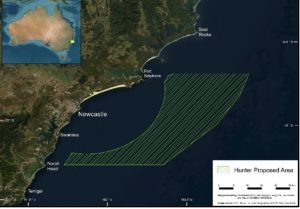
OFFSHORE wind researcher Dr Sven Teske says the Hunter region is uniquely positioned to be a leading site for offshore wind power generation due to its availability of consistent wind resources, existing infrastructure and harbour access.
Dr Teske is an Associate Professor and Research Director at the Institute for Sustainable Futures (IFS), University of Technology Sydney, whose research focuses on energy decarbonisation pathways.
In 2021, prompted by an international boom in offshore wind projects, the ISF led research that found Australia has the perfect conditions to support a thriving offshore wind industry.
The research aimed to properly understand the feasibility and potential for offshore wind in Australia, and to identify any barriers to its large-scale development.
The research also looked at the role offshore wind might play in a just transition to renewable energy, identifying opportunities to incorporate existing infrastructure and create jobs for coal, gas and mining workers.
The report located good sites for offshore wind in Queensland, New South Wales, Victoria, Tasmania, South Australia and West Australia, all close to transmission grids and with potential to produce a high capacity of energy.
The research found that in Newcastle there were strong winds offshore at times of low onshore wind and solar generation, which would help maintain a consistent supply of renewable energy.
Dr Teske told News Of The Area there were multiple considerations when selecting an area suitable for offshore wind projects.
“Australia has really good wind resources all around the coast,” he said.
“Then you filter out areas based on the water depth, in terms of it not being too deep.
“Most of the areas around Australia would need floating wind farms, because it is quite deep.
“There are not too many places where we have less than 40 or 50 metres.
“The third criteria is the grid connection.
“We need really good grid connection because offshore wind zones are so large.
“We are talking a gigawatt or two gigawatts or even more, so that is the capacity of one or two coal powered plants.”
The Hunter’s existing coal infrastructure and network give it an advantage moving forward with offshore projects.
“The good locations around Australia boil down mainly to places that have coal infrastructure and a large grid,” Dr Teske said.
“The advantages are that the offshore wind turbines can connect to the grid where the coal powered plants are connected right now.
“That’s why the Hunter is a really good location.”
The final key criteria Dr Teske outlined was access to a large harbour to transport equipment.
“You need a harbour for working boats, all the equipment and infrastructure, similar to offshore oil or offshore gas.
“You also need a lot of space.
“If the wind turbines are under construction, the rotor blades are really large.
“You need a large space to put them, and Newcastle Harbour is perfect for that.”
Dr Teske said international examples have demonstrated the ability of coal powered energy production regions to transition to offshore wind.
“The coal will have to leave at some point, and then there is a lot of space available and that is perfect for offshore wind.
“There are a lot of international examples where that has been done, where either a coal or gas harbour has been converted.
“For example in Scotland, Netherlands, Germany, Denmark, the US and China.”
Dr Teske has been involved in offshore wind research since the early 2000’s, and believes now is the perfect time for Australia to begin investigating offshore wind projects.
“It is not a technology which is new and has never been tested.
“The first offshore wind farm was built 30 years ago.
“It is new for Australia but not for Europe or Asia.
“I think that it is the time now for Australia as the technology has been largely developed.
“Australia’s coal powered plants are very old, 35 years plus, so we need to replace them anyway.
“The wind conditions all around are so good that we are close to the base load production from offshore wind.
“It is a perfect replacement.”
With countries abroad so far advanced in their offshore wind generation journeys, Dr Teske said Australia can take learnings from international examples to reduce risks and impacts on the environment.
“There are a lot of experiences that can be considered from an environmental impact perspective.
“It needs to be properly assessed in terms of marine protection areas, fisheries, defence, shipping lanes etc.
“From my international experience, there is always a phase of a year or two, or sometimes even longer, to find the priority zones for offshore winds and then stick to those.
“There is also long term research about impact on birds and marine animals.
“If it’s done properly and in the right location, the results are always quite positive.”
Dr Teske told News Of The Area research is underway regarding the transition of jobs in the coal industry to offshore wind roles.
By Doug CONNOR
